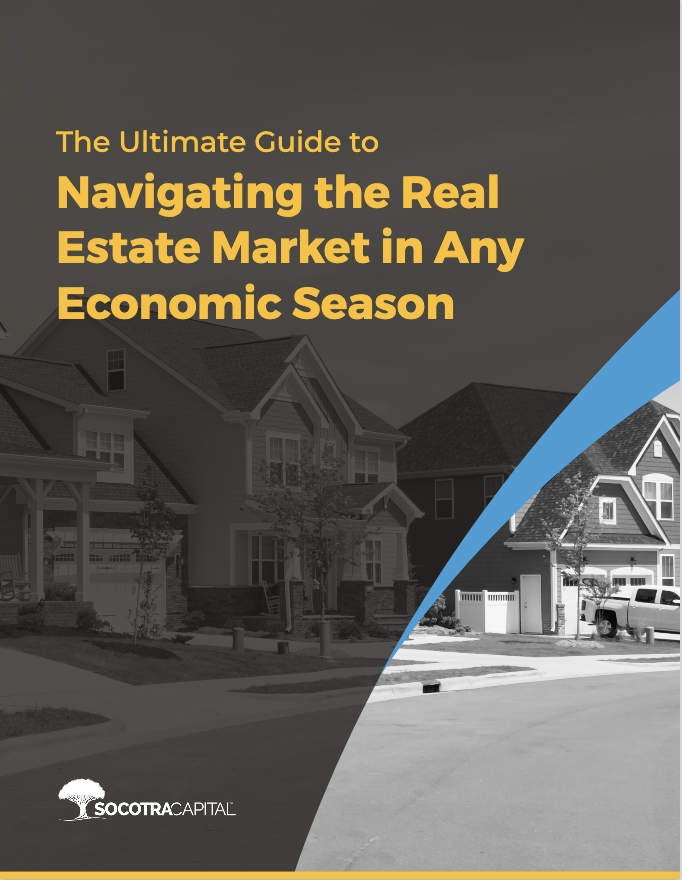The Ultimate Guide to Navigating the Real Estate Market in Any Economic Season

Introduction
If there is any certainty about the economy, it’s that there are consistent cycles. The economy ebbs and flows like the tides, and just like in nature, sometimes the transitions are smooth and calm, and sometimes they are stormy and tumultuous. Nobody can predict the timing of these cycles or how extreme they will be, but when you’re trying to make money navigating the market, you can look for indicators of change and adjust your real estate investments to get the best returns.
This guide describes the typical economic seasons and how real estate investors can capitalize on them. We can’t predict the future, but we can help you better see the storm clouds or sunny skies ahead.
Download a PDF version of this guide by filling out this form, or keep scrolling to read.

Chapter 1
Chapter 2
Chapter 3
Chapter 4
Chapter 5
Chapter 6
Chapter 7

Chapter 1
Typical Market Seasons
Just as in nature, the economic market has four distinct seasons that tend to have a rhythmic cycle.
1. Expansion
In an expanding market, the economy is ripe for growth—much like plants blooming in spring. Typically speaking, property values appreciate, potential investment opportunities abound, transactions are more numerous, interest rates are below recent highs, and unemployment is trending down from a peak. All of this contributes to more economic activity and a growing market.
2. Peak
An economic peak arrives when growth reaches its maximum rate. In nature, this is akin to vegetation overgrowing or animals crowding out other species. After a period of economic growth, imbalances start to appear and inflation typically begins to pick up, setting the stage for a market correction.
3. Contraction
In an economic contraction, growth slows and unemployment rises. The Federal Reserve often takes action and tries to correct imbalances, which leads to tighter credit and decreases in spending. As people spend less, prices tend to plateau or decline. A contracting economy is much like autumn. Plants and animals prepare for a cooler season when they must conserve energy and protect their precious resources.
4. Trough
Like the dead of winter, an economic trough is when the economy hits a low point. Unemployment has reached its peak, credit is less available, and prices fall. Fortunately, like the optimism that comes with days lengthening at the end of winter, a recovery or expansion is likely around the corner. This is when savvy investors prepare to sow seeds for the next cycle. Seeds sown here can set you up for success next spring!
Timing
Cycles can vary significantly, but the average length is about 5 ½ years. However, the recent longer bull cycle that started in 2009 clearly demonstrates that economic patterns are not as predictable as the annual seasons in nature. For real estate investors, the key to navigating the market is to take advantage of the current conditions and recognize the signs of change and ensure that you are prepared for the next cycle to come.

Chapter 2
Real Estate Investment During Expansion
Investing during an expansion is likely one of the better times to invest as the rising tide lifts all boats. This is the time to feel emboldened to take risks and make hay while the sun shines. Multiply your gains by leveraging equity to get a better rate of return, even though interest rates might be higher.
A market expansion is also a good time to diversify investments and purchase a mix of trust deeds, real estate, stocks, and so on. Look for real estate investments that don’t fit the typical scenario, such as:
Fix-and-flips (although you may be purchasing at a premium)
Subdivision purchasing and mapping
Other prospective market opportunities where you have the potential to unlock value
This is the time for high-risk flips, investment in retail spaces, or purchasing office properties that could be improved. Because these types of opportunities often fall outside the scope of a traditional lender, you’ll need to work with a nonbank lender for alternative investments such as subdivisions, fix-and-flips, and commercial bridge loans.
%20(1).jpeg?width=1159&height=580&name=The%20Ultimate%20Guide%20to%20Navigating%20the%20Real%20Estate%20Market%20in%20Any%20Economic%20Season%20Chapter%203%20(1)%20(1).jpeg)
Chapter 3
Real Estate Investment During a Peak
When the peak arrives, it’s time to prepare for an impending contraction. Keep an eye out for a rise in condominium and other high-density construction projects because this is a common indicator that the market is peaking. Investments during this time should be less risky and able to deliver the cash flow necessary to maintain them during a recession. This might include rentals that require minimal improvements and are already 70-plus percent leased.
This is also likely the best time to either reduce leverage where you might be overextended or take on leverage where you might own something free and clear. Strive for a "Goldilocks" scenario where you have cash in the bank but serviceable debt.
Look for distressed properties and sellers under duress, but be careful not to overextend during peak season, even if good deals are readily available. You may not get the type of return you would get in an expanding economy, but a safer investment will help protect you as the economy shifts toward a contraction. Consider a cash-out refinance or pull out equity to prepare for a recession.

Chapter 4
Real Estate Investment During a Contraction
During an economic contraction, interest rates may decrease, but lenders tighten their lending requirements. As the economy cools, purchase rental properties with 1-4 units or hold on to flips and convert them to rentals. Look for multiple exits in the event you can't sell a flip. If the property sits in a good rental location, you're golden. Consider higher down payments if interest rates are high as a way to "buy down" the rate.
This is also a good time to think beyond one asset class. If you only invest in residential real estate, you might look for other market opportunities, such as commercial rental properties with seasoned tenants in industries that are more resilient and businesses that thrive in a recession, such as utilities, finance, and healthcare. Industrial tenants that serve the B2B market tend to be more durable and can ride out economic cycles. You should be looking for investors who want to shed projects, potentially at a discount. Keep your eyes and ears open for when opportunity knocks. When the tide turns, you want to be in the driver's seat.
"You should be looking for investors who want to shed projects, potentially at a discount."

Chapter 5
Real Estate Investment During a Trough
At the lowest points in the economic cycle, continue investing in properties that provide cash flow so you can service your debt. Hang on to investments if you can at least break even, and wait it out until the expansion increases prices. Timing the peak or trough is difficult, and waiting for the bottom is like catching a knife—scary! The key is to be patient and ride out the trough until the next expansion comes around or use the dollar-cost averaging trading approach with money you can afford not to use in the next 5-10 years.

Chapter 6
General Considerations for Real Estate Investment
No matter what economic season we’re in, there are some general guidelines to follow when navigating the market.
Location is always a factor in any real estate investment. Higher-income locations tend to be less impacted, and newer tracts tend to swing more.
In general, properties that have the most potential for appreciation also have the farthest to fall. When timed right, this opens the door to discount opportunities. However, in real estate, it’s important not to think in terms of just the sale price. Think about the purchase and improvement costs and how you can make a positive cash flow investment that takes a margin for error into account.
Making the right deals at the right time is important at every phase of the market. Understand which moves are smart, and do the research to make sure you’re getting the right deals.
"Making the right deals at the right time is important at every phase of the market."

Chapter 7
How Socotra Capital Helps
Unlike many hard money lenders, Socotra Capital is a direct lender, which makes us more reliable than other alternatives in every phase of the cycle—but especially in a down market.
Most importantly, because we're a direct private fund and balance sheet lender, our rates are not beholden to Fed rates because we don't borrow our money. We’re also able to offer flexible terms that traditional banks aren’t able to do, especially when they have more strict qualifications in down times.
We offer hard money loans for a broad range of real estate investment opportunities, including fix-and-flips, cannabis properties, residential rehab, and more. If you already own real estate, you can rely on your equity for lines of credit and bailout loans to help you get through downturns.
One of our biggest advantages for competitive real estate investors is the ability to close quickly—in as few as five days. This is especially beneficial when you’re navigating the market and need an edge in competitive expansion periods.
If you have equity and a profitable real estate opportunity, you can get a loan with Socotra. Get started today with our quick online form.
Download a PDF version of this guide by filling out this form
Simply fill out this form to receive a PDF version of our guide.


.jpg?width=450&length=450&name=GettyImages-1306217462%20(1).jpg)










